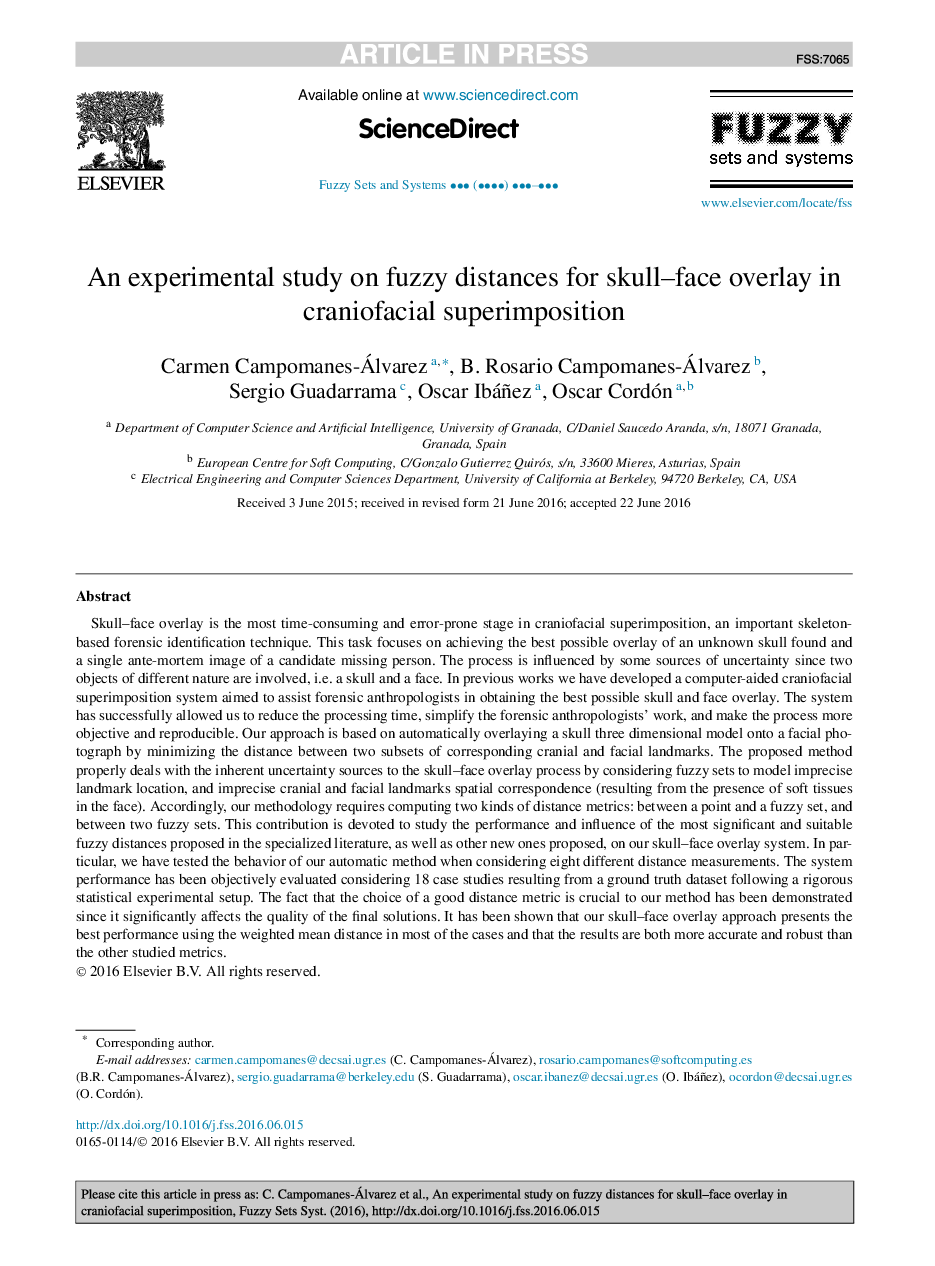| کد مقاله | کد نشریه | سال انتشار | مقاله انگلیسی | نسخه تمام متن |
|---|---|---|---|---|
| 4943926 | 1437717 | 2017 | 20 صفحه PDF | دانلود رایگان |
عنوان انگلیسی مقاله ISI
An experimental study on fuzzy distances for skull-face overlay in craniofacial superimposition
ترجمه فارسی عنوان
یک مطالعه تجربی بر روی فضاهای فازی برای پوشاندن جمجمه چهره در پوشش سوسپاندرمانی
دانلود مقاله + سفارش ترجمه
دانلود مقاله ISI انگلیسی
رایگان برای ایرانیان
کلمات کلیدی
شناسایی قانونی، سوپاپ سرطانی پوشش جلدی، نشانه های فازی، فاصله فازی، الگوریتمهای تکاملی، سیستم های فازی ژنتیکی،
ترجمه چکیده
پوشش جلدی، مرحله ای است که بیشترین زمان و خطا را در برهم خوردن فکری، یک روش شناسایی قانونی مبتنی بر اسکلت مهم است. این وظیفه بر دستیابی به بهترین پوشش احتمالی یک جمجمه ناشناخته و یک تصویر متحرک پیش از مرگ یک فرد از دست رفته متمرکز است. این فرآیند تحت تأثیر برخی از منابع نااطمینی قرار گرفته است، زیرا دو اشیاء با طبیعت متفاوت درگیر هستند، به عنوان مثال جمجمه و چهره. در آثار قبلی ما یک سیستم سوپاپی با سیستم کامپیوتری با هدف کمک به انسان شناسان قانونی در به دست آوردن بهترین چهره و چهره با قابلیت رو به رو شدن ایجاد کرده ایم. این سیستم به موفقیت ما اجازه می دهد تا زمان پردازش را کاهش دهیم، کارشناسان حقوق بشری را ساده تر کنیم و روند را بیشتر هدفمند و قابل تکرار کنیم. رویکرد ما این است که به طور خودکار بر روی یک مدل سه بعدی سه بعدی بر روی یک عکس چهره قرار می گیرد با حداقل فاصله بین دو زیر مجموعه از نشانه های جمجمه و صورت. روش پیشنهادی به درستی از منابع نااطمینی ذاتی به فرایند پوشش جمجمه با در نظر گرفتن مجموعه های فازی برای مدل سازی موقعیت نقطه عطفی نامناسب و مکاتبات فضایی نامناسب جمجمه و صورت (که از طریق وجود بافت نرم در چهره) نامشخص است، به درستی بررسی می شود. بر این اساس، روش ما نیاز به محاسبه دو نوع معیارهای فاصله: بین یک نقطه و یک مجموعه فازی و بین دو مجموعه فازی دارد. این سهم برای بررسی عملکرد و تأثیر مهمترین و مناسب فازهای فازی پیشنهاد شده در ادبیات تخصصی و همچنین سایر موارد جدید ارائه شده بر روی سیستم پوشش چهره ما اختصاص داده شده است. به طور خاص، ما رفتار روش اتوماتیک ما را با در نظر گرفتن هشت اندازه مختلف فاصله مقایسه کردیم. عملکرد سیستم به طور عینی با توجه به 18 مطالعه موردی ناشی از یک مجموعه داده های حقیقی به دنبال یک راه اندازی آزمایشی دقیق آماری، مورد بررسی قرار گرفته است. این واقعیت که انتخاب روش متریک مناسب برای روش ما بسیار مهم است، نشان داده شده است، زیرا آن را به طور قابل توجهی بر کیفیت راه حل های نهایی تاثیر می گذارد. نشان داده شده است که رویکرد پوشش جمجمه ما بهترین عملکرد را با استفاده از میانگین فاصله وزنی در بیشتر موارد نشان می دهد و نتایج هر دو دقیق تر و قوی تر از سایر معیارهای مورد مطالعه می باشند.
موضوعات مرتبط
مهندسی و علوم پایه
مهندسی کامپیوتر
هوش مصنوعی
چکیده انگلیسی
Skull-face overlay is the most time-consuming and error-prone stage in craniofacial superimposition, an important skeleton-based forensic identification technique. This task focuses on achieving the best possible overlay of an unknown skull found and a single ante-mortem image of a candidate missing person. The process is influenced by some sources of uncertainty since two objects of different nature are involved, i.e. a skull and a face. In previous works we have developed a computer-aided craniofacial superimposition system aimed to assist forensic anthropologists in obtaining the best possible skull and face overlay. The system has successfully allowed us to reduce the processing time, simplify the forensic anthropologists' work, and make the process more objective and reproducible. Our approach is based on automatically overlaying a skull three dimensional model onto a facial photograph by minimizing the distance between two subsets of corresponding cranial and facial landmarks. The proposed method properly deals with the inherent uncertainty sources to the skull-face overlay process by considering fuzzy sets to model imprecise landmark location, and imprecise cranial and facial landmarks spatial correspondence (resulting from the presence of soft tissues in the face). Accordingly, our methodology requires computing two kinds of distance metrics: between a point and a fuzzy set, and between two fuzzy sets. This contribution is devoted to study the performance and influence of the most significant and suitable fuzzy distances proposed in the specialized literature, as well as other new ones proposed, on our skull-face overlay system. In particular, we have tested the behavior of our automatic method when considering eight different distance measurements. The system performance has been objectively evaluated considering 18 case studies resulting from a ground truth dataset following a rigorous statistical experimental setup. The fact that the choice of a good distance metric is crucial to our method has been demonstrated since it significantly affects the quality of the final solutions. It has been shown that our skull-face overlay approach presents the best performance using the weighted mean distance in most of the cases and that the results are both more accurate and robust than the other studied metrics.
ناشر
Database: Elsevier - ScienceDirect (ساینس دایرکت)
Journal: Fuzzy Sets and Systems - Volume 318, 1 July 2017, Pages 100-119
Journal: Fuzzy Sets and Systems - Volume 318, 1 July 2017, Pages 100-119
نویسندگان
Carmen Campomanes-Álvarez, B. Rosario Campomanes-Álvarez, Sergio Guadarrama, Oscar Ibáñez, Oscar Cordón,
